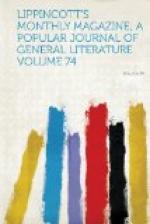To see Dr. Wyman in his museum was one of the most pleasant exhibitions of the man at his best. I well remember one Sunday afternoon in May three years ago, when, walking in Cambridge with H——, one of the most prominent of our great railway presidents—and, better than this, a man notable for genial social qualities, high culture and a broad range of the readiest sympathies—I proposed to him to call on Wyman and ask him to show us the Archaeological Museum. We found Wyman at home, and if you had asked a bright little girl to show you her baby-house she could have been no better pleased than he. At first, as we went from case to case, he was quiet and said little, but as we showed the interest and admiration we so warmly felt, he also grew eager and vivid in description, until as he went on his talk became a marvel of illustrative learning—so wide, so varied, so complete, that we were carried along the current of his thoughts in wonder at this strange combination of intense interest, of almost childlike satisfaction, of a concentration on his subject of vast antiquarian knowledge and of absolutely perfect anatomical skill. Mr. H—— called his attention to the curious distortions and odd enlargements of the protruded tongue in some of the Alaskan wooden masks, and on this little text he was away in a moment from case to case in the museum, and from century to century, pointing out the use of the tongue as an organ of facial expression in various ages. Here were Roman or Greek examples, here Sioux or Alaskan types of the same usages, and here was a new thought he had never had before, and we were thanked for awakening it; and so in his talk over this little point he showed us how barbarian natures had like thoughts everywhere, and, as much amused as we, he quoted and laughed and talked, still always pleased and easy under the vast weight of learning which, coming from his lips, was so utterly free from the least appearance of being ponderous or tiresome. I think I never knew any other man whose learning sat upon him as lightly or was given to others as gracefully.




